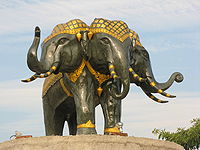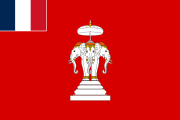Airavata

Airavata (Sanskrit: ऐरावत, romanized: airāvata, lit. 'belonging to Iravati') is a divine elephant, characterized by four tusks, seven trunks and a white complexion. He is the "king of elephants" also serves as the main vehicle for the deity Indra.[1] It is also called 'abhra-Matanga', meaning "elephant of the clouds"; 'Naga-malla', meaning "the fighting elephant"; and 'Arkasodara', meaning "brother of the sun".[2] 'Abhramu' is the elephant wife of Airavata. Airavata is also the third son of Iravati. In the Mahabharata he is listed as a great serpent.[3]
Hindu tradition
[edit]
The appearance or birth of Airavata varies according to different Hindu texts. In the Ramayana, Airavata was born to Iravati (descendant of the sage, Kashyapa) whereas, the Vishnu Purana notes that Airavata was born from the churning of the ocean of milk.[1][4] According to the Matangalila, Airavata was born when Brahma sang sacred hymns over the halves of the egg shell from which Garuda hatched, followed by seven more male and eight female elephants. Prithu made Airavata king of all elephants. One of his names means "the one who knits or binds the clouds" since myth has it that these elephants are capable of producing clouds. The connection of elephants with water and rain is emphasized in the mythology of Indra, who rides the elephant Airavata when he defeats Vritra.
It is believed that the elephant guards one of the points of compass.[5] Airavata also stands at the entrance to Svarga, Indra's palace. In addition, the eight guardian deities who preside over the points of the compass each sit on an elephant (world elephant). Each of these deities has an elephant that takes part in the defense and protection of its respective quarter. Chief among them is Airavata of Indra. There is a reference to Airavata in the Bhagavad Gita:
Of horses, know Me to be the nectar-born Uchchaihshravas; of lordly elephants, Airavata and of men, the monarch.[6]
Airavata is also known for being the cause of the churning of the ocean of milk. Once sage Durvasa presented a garland to Indra, who passed it on to Airavata. The elephant then threw the garland on to the ground, which angered Durvasa and resulted in the demigods to be "subject to old age and death." Reversing the curse required the devas to retrieve the nectar of immortality by churning the ocean of milk.[7][1]
At Darasuram near Tanjore is a temple where it is believed that Airavata worshipped the Lingam; the Lingam is named after him as Airavateshwara. This temple, which abounds in rare sculpture and architectural workmanship, was built by Rajaraja Chola II (1146–73 CE).[8]
Jain tradition
[edit]In Jain tradition, when a Tirthankara is born, Indra descends with his consort, Shachi, riding their mount, the great elephant Airavata, to celebrate the event.[9]
Flags with Airavata
[edit]- Laos
-
Flag of French Laos (1893–1952)
-
Flag of Laos (1952–1975)
-
Laotian royal standard (1952–1975)
- Siam (Thailand)
-
Flag of the Bangkok Metropolitan Administration
Erawan
[edit]
Erawan (Thai: เอราวัณ, from Pāḷi Erāvana, or Sanskrit Airāvana) is one of the Thai names of Airavata. It is depicted as a huge elephant with either three or sometimes thirty-three heads which are often shown with more than two tusks. Some statues show Indra, the king of Tavatimsa Heaven, riding on Erawan.[citation needed]

The elephant became the symbol of Bangkok by association with Indra during its foundation as the capital of the new Rattanakosin Kingdom .[10] It is also sometimes associated with the old Lao Kingdom of Lan Xang and the defunct Kingdom of Laos, where it was more commonly known as the "three-headed elephant" and had been used on the royal flag.[11]
In popular culture
[edit]Airavata is a recruitable character in the Megami Tensei video game series.
Airavata is referenced in the song "The Animal Tent" on the album The Circus by The Venetia Fair:
Here comes Airavata; the elephant controls the rainclouds, His skin the rumbling earth (Airavata!)
Airavata is the name of the Volvo bus service that Karnataka State Road Transport Corporation provides.[12]
See also
[edit]Citations
[edit]- ^ a b c Dalal, Roshen (2010). Hinduism: An Alphabetical Guide. Penguin Books India. pp. 13–14. ISBN 978-0-14-341421-6.
- ^ Dowson, John (1870). A Classical Dictionary of Hindu Mythology and Religion, Geography, History, and Literature. London: Trübner & Company. p. 180.
- ^ Ganguli, Kishori Mohan. "SECTION XXXV". Mahabharata. Pratap Chandra Babu.
- ^ Williams, George M. (27 March 2008). Handbook of Hindu Mythology. OUP USA. p. 52. ISBN 978-0-19-533261-2.
- ^ Gopal, Madan (1990). K.S. Gautam (ed.). India through the ages. Publication Division, Ministry of Information and Broadcasting, Government of India. p. 64.
- ^ Bhagavad Gita (Chapter 10, Verse 27) Archived 30 September 2007 at the Wayback Machine
- ^ Lochtefeld, James G. (2002). The Illustrated Encyclopedia of Hinduism: A-M. Rosen. p. 19. ISBN 978-0-8239-3179-8.
- ^ Ali Javid; ʻAlī Jāvīd; Tabassum Javeed (2008). World Heritage Monuments and Related Edifices in India. Algora Publishing. p. 57.
- ^ Goswamy 2014, p. 245.
- ^ Roy, Edward Van (2018). Siamese Melting Pot. Flipside Digital Content Company Inc. pp. 16–17. ISBN 978-981-4762-85-4.
- ^ Reynolds, Frank E., ed. (1982). Three worlds According To King Ruang: A Thai Buddhist Cosmology. Berkeley. ISBN 0-89581-153-7.
- ^ "KSRTC launches Volvo buses with pantry and toilet". The Hindu. 19 July 2012. Retrieved 27 August 2014.
General references
[edit]- Goswamy, B. N. (2014), The Spirit of Indian Painting: Close Encounters with 100 Great Works 1100–1900, Penguin Books, ISBN 978-0-670-08657-3
External links
[edit] Media related to Airavata at Wikimedia Commons
Media related to Airavata at Wikimedia Commons







